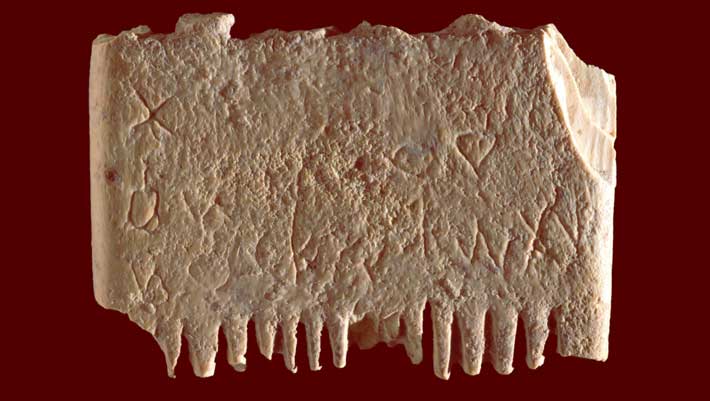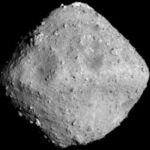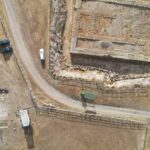The small inscribed ivory comb was found at Tel Lachish, a key Canaanite city-state in the 2nd millennium BCE, the second most important city in the Judean Kingdom after Jerusalem in the Iron Age, and a major city in the Persian and Early Hellenistic eras. The inscription in early Canaanite script expresses the wish that the comb will eradicate the lice from the hair and beard of the owner of the comb.
The 3,700-year-old ivory comb from Tel Lachish, Israel. Image credit: Dafna Gazit, Israel Antiquities Authority.
The inscribed ivory comb from Tel Lachish is relatively small, measuring roughly 3.5 by 2.5 cm (1.4 by 1 inches).
The comb has teeth on both sides. Although their bases are still visible, the teeth themselves were broken in the antiquity.
“The central part of the comb is somewhat eroded, possibly by the pressure of fingers holding the comb during haircare or removal of lice from the head or beard,” said Hebrew University of Jerusalem’s Professor Yosef Garfinkel and colleagues.
“The side of the comb with six thick teeth was used to untangle knots in the hair, while the other side, with 14 fine teeth, was used to remove lice and their eggs, much like the current-day two-sided lice combs sold in stores.”
The inscription on the comb contains 17 tiny letters that vary in width from 1 to 3 mm, engraved on the not-completely-smooth surface of the artifact.
Most of the letters survive to some degree, except for letter 13, which was totally damaged, and letter 14, of which only a few parts remain.
The letters form seven words that for the first time provide us with a complete reliable sentence in a Canaanite dialect, written in the Canaanite script.
The inscription reads: ‘May this tusk root out the lice of the hair and the beard.’
“This is the first sentence ever found in the Canaanite language in Israel,” Professor Garfinkel said.
“There are Canaanites in Ugarit in Syria, but they write in a different script, not the alphabet that is used till today.”
“The Canaanite cities are mentioned in Egyptian documents, the Amarna letters that were written in Akkadian, and in the Hebrew Bible.”
“The comb inscription is direct evidence for the use of the alphabet in daily activities some 3,700 years ago. This is a landmark in the history of the human ability to write.”
The researchers also analyzed the comb for the presence of the remains of ancient lice under a microscope.
“Remains of head lice, 0.5-0.6 mm in size, were found on the second tooth,” they said.
“The climatic conditions of Tel Lachish, however, did not allow preservation of whole head lice but only of the outer chitin membrane of a first or second nymph stage head louse.”
The discovery is described in a paper in the Jerusalem Journal of Archaeology.
_____
Daniel Vainstub et al. 2022. A Canaanite’s Wish to Eradicate Lice on an Inscribed Ivory Comb from Lachish. Jerusalem Journal of Archaeology 2: 76-119; doi: 10.52486/01.00002.4




